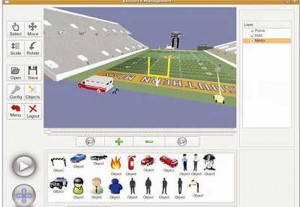It’s half time, and you’re happily ensconced in your favorite seat in your favorite sports arena — in honor of the World Cup, let’s say it’s Royal Bafokeng in Rustenburg with hopes of following to Soccer City Stadium in Johannesburg. Your team has a comfortable lead, and you’ve just signaled the beer man for a frosty cold one when the public address announcer tells you and your 69,999 fellow fans that the stadium is to be evacuated immediately.
What comes next, panic and mayhem or an orderly procession from seat to street to safety? If you’ve been primed by action movies like Two-Minute Warning, Black Sunday or The Sum of All Fears, you know the answer, and it’s not pretty. (You might also decide to stay away from American football games, but then Royal Bafokeng has made at least one alleged terror list.)
But if the management of your stadium has prepared for the possibility of a terrorist attack or a sudden natural disaster by taking advantage of a new breed of simulation software nicknamed SportEvac, your chances of making it out safely likely will improve since the venue staff will have had virtual practice of what they can do to solve these on-the-fly evacuation crises.
“The problem is,” said Derrick Mayes, director and CEO of Executive Action Sports & Entertainment, “these stadiums are built to get people in, not to get people out. We need to create better exit strategies.” (Mayes has had a vested interest in the issue: The onetime wide receiver played in the Superdome on the Green Bay Packer team that won Super Bowl XXXI).

Previously, “oh-my-god-what-if” planning was done with models and mock-ups of people and vehicles, as well as the relatively inflexible first-generation computer simulation software that wasn’t able to figure in crowds larger than 5,000. The picture has brightened considerably, say the creators and managers of SportEvac, which was developed by the National Center for Spectator Sports Safety & Security (or NCS4) at the University of Southern Mississippi. The software project received funding from the U.S. Department of Homeland Security’s Science and Technology Directorate.
“Oftentimes, the best solution is on the front end, when you put together security engineers, architects well versed in security and security consultants like ourselves to implement those strategies,” said Mayes.
“Also of strategic importance is the willingness of the team owners and the organizations that own these venues to get security assessments of their stadiums up front.”
“SportEvac isn’t simply more realistic. It will become a national standard,” according to program manager Mike Matthews of the directorate’s Infrastructure and Geophysical Division. He cites SportEvac’s ability to use, within a virtual 3-D “e-stadium,” up to 70,000 avatars that can be programmed to react to threats as would humans — i.e. unpredictably. And if someday you’re sitting in the stadium parking lot wondering how you’d ever get out of there in a hurry, the program also covers that.
Armed with SportEvac and the blueprints of actual stadiums, security agents can see what happens if an orderly exit suddenly becomes disorderly; this scenario can be factored in and then tracked. And, say its developers, each time it is used, its potential value will increase because it is built on “open modular code” similar to an open source Web browser.
According to the project’s lead investigator, Lou Marciani of NCS4, “The SportEvac developers have involved first responders and stadium security personnel in all phases of development to make the tabletops as realistic as possible and, therefore, as useful as possible in training. SportEvac is in the alpha stage. We plan on doing three pilot tests — at the University of Southern Mississippi, the University of Tennessee and the United States Military Academy.”
The University of Southern Mississippi is leading the way toward greater stadium safety. It is creating 3-D virtual models of seven of Mississippi’s sports stadiums, and this year, security teams from its various athletic departments, using summits and workshops, will test and refine SportEvac with input from Mississippi’s Homeland Security agents, the Mississippi Emergency Management Agency, local police and security specialists from professional sports. Once SportEvac is set up and OK’d by the seven schools, Marciani says the University of Southern Mississippi will make an advanced version available to other colleges and universities, pro sports sites and amateur sports organizations.




